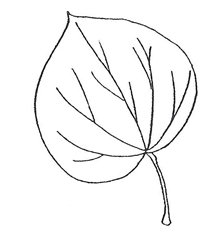Cercis canadensis (ser’-sis kan-a-den’-sis)
Family: Caesalpiniaceae, Cassia (formerly Fabaceae, legume family)
Key Steps
- 1b – Alternate leaf arrangement — go to 18
- 18a – Leaf simple — go to 19
- 19b – Thornless — go to 22
- 22e – All leaves unlobed — go to 31
- 31b – Leaf is round or heart-shaped — go to 35
- 35a – Petiole is round — go to 36
- 36a – Leaf margin entire all around. Leaf is 3 inches long — Eastern Redbud
- 35a – Petiole is round — go to 36
- 31b – Leaf is round or heart-shaped — go to 35
- 22e – All leaves unlobed — go to 31
- 19b – Thornless — go to 22
- 18a – Leaf simple — go to 19
Description
 Leaf: Dark green, heart-shaped base, pointed tip, 2-6 inches long, smooth margin. Leaf is thin, papery. May have tufts of hair in veins axils beneath. 5-7 prominent veins branching from leaf base. Long (up to 4 inches), slender petiole swollen at each end.
Leaf: Dark green, heart-shaped base, pointed tip, 2-6 inches long, smooth margin. Leaf is thin, papery. May have tufts of hair in veins axils beneath. 5-7 prominent veins branching from leaf base. Long (up to 4 inches), slender petiole swollen at each end.
Bud: Small, round, purplish-red. Usually more than one bud per leaf scar. True terminal bud absent. Flower buds are larger and in clusters, stalked, even on the branches. 5-6 scales, may have accessory buds; partially covered by leaf scar.
Leaf Scar: Raised, inverted triangle. Fringed with hair at top, 2-3 lines from the scar. 3 raised bundle scars.
Stem: Hairless, slender, smooth, zigzag. Young: dark brown, lustrous. Older: dull, darker.
Bark: Smooth, gray with red streaks. Scaly with age.
Pith: White, often streaked with red. Solid.
Flower: Pinkish-purple, appearing before leaves in April or May, along preceding year’s branches and trunk. Very showy pea-like clusters of blossoms.
Fruit: 2-4 inch long, flat, dark pink-red to purplish bean-like pods. May remain all winter. Usually six seeds.
Habit: Dividing close to ground, low, wide-topped, flat head. Horizontal branching. Can be multi-trunked. 15 to 25 feet tall. Performs poorly in Colorado’s climate, nicknamed “deadbud”.
Culture: Moderate water requirements. Likes a protected location. Intolerant of late spring frosts. Sun or part shade.
Resources




